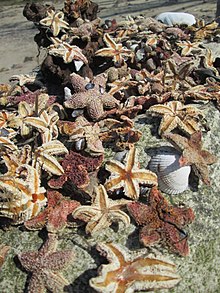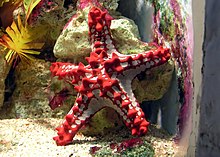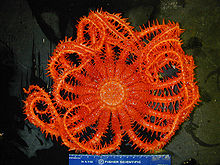Starfish
| Starfish | ||||||||||||
|---|---|---|---|---|---|---|---|---|---|---|---|---|

|
||||||||||||
| Systematics | ||||||||||||
|
||||||||||||
| Scientific name | ||||||||||||
| Asteroidea | ||||||||||||
| de Blainville , 1830 |
Starfish (Asteroidea; derived from ancient Greek ἀστήρ astḗr " star " and εἶδος eídos "form, shape") are a class of Eleutherozoa within the echinoderm tribe . About 1,600 are most recent types of starfish known with which it is the fifth largest group of animals within the echinoderms (Echinodermata) after the brittle stars form (Ophiuroida).
morphology
Eidonomy
The basic shape of the body is usually a five-armed star, the arms of which become evenly slimmer towards the tips. In many species the interradii (area between the arms) can become so wide that a pentagon is created. This can be arched and pillow-like ( culcita ) or extremely flat ( Anseropoda placenta ). Almost spherical shapes are also possible. Representatives of the genus Podosphaeraster resemble a stingless sea urchin. On the other hand, species of the genera Labidiaster , Brisinga and Freyella are reminiscent of brittle stars with their round, evenly thin long arms and a separate central body disc . The body size ranges from 1 cm for Asterina phylactica to over 1 m for Freyella remex , but the majority is around 20 cm. Many starfish have more than 5 arms. In the case of the sun stars (Solasteridae), the number is age-dependent. Crossaster papposus has 8 to 15 arms, species of the genus Heliaster over 40 and the genus Labidiaster has 25 to 50 arms. The number of arms can also vary within a species. So four-, six- and seven-armed specimens can occur in the species Oreaster reticulatus .
anatomy
On the underside of the arms there are numerous feet belonging to the ambulacral system, which are used for locomotion. A group of movable feet stretches out in the same direction, attaches itself to the base and then shortens again. With this shortening, the animal's body is pulled, not quickly, but turned and evenly.
Numerous small knots and bumps can be clearly felt on the top of the starfish. These arise from limestone platelets connected like a vortex under the skin. The calcareous platelets form the animal's skin skeleton. Since the plates can be moved against each other despite the connection, the starfish retains its mobility.
Starfish don't have eyes with which they can see or identify objects. However, there are several light sensory cells on their arms in order to be able to perceive differences in brightness in their surroundings.
nutrition
In the temperate latitudes, the majority of starfish live predatory or on carrion , while in the tropics and subtropics there are also many detritus, algae and mud eaters, such as the pillow stars , the purple stars (family Echinasteridae ) and the comet stars (genus Linckia ). The predatory sea stars eat mostly slow and sessile animals such as mollusks ( clams , snails , Grabfüßer ), cancers (particularly barnacles ), polychaetes , echinoderms ( sea cucumbers , starfish, brittle stars , sea urchins ), cnidarians ( anemones , corals ), sponges , bryozoans and Sea squirts , while some species ( Stylasterias forreri , Astrometis sertulifera and Labidiaster annulatus ) themselves hunt decapods and fish with the help of their pedicellariums . Many starfish species, including the Californian species Pisaster ochraceus , form an important link in the food structure as approximate top predators .
The mouth opening is in the middle of the body on the underside of the animals . In many predatory species such as the Asteriidae or the sun stars, the stomach can be everted and is inserted into the clams that serve as food, whereby the little feet spread the clamshells apart with a force of up to 50 Newtons. Thus, digestion in these species takes place outside the body ( extraintestinal digestion ). When the prey is pre-digested, the starfish pulls the stomach back inside with food pulp. The comb stars, on the other hand, swallow their mostly smaller prey as a whole, often in very large numbers. In these species, as in many detritus, algae and mud eaters, food is digested in the stomach (intraintestinal digestion).
Reproduction

Starfish are predominantly separate sexes and show no sexual dimorphism . Several species are hermaphrodites , for example Asterina gibbosa is protandric , but simultaneous hermaphrodites are also known ( Asterina minor and Asterina phylactica ). In populations of Echinaster sepositus on the Italian coast, up to 23% hermaphrodites occur. In the great majority of cases, fertilization takes place externally in open seawater, and development takes place via a free-swimming Bipinnaria larva that lives as a plankton of microorganisms and then a Brachiolaria larva that attaches to the substrate with an adhesive disk and which Metamorphosis into a juvenile starfish. In Asterina gibbosa, on the other hand, the embryos feed on egg yolks and hatch directly as brachiolaria. The little Asterina phylactica even hatches its young, which only leave their mother when they are finished starfish. This dies soon after.
There is also an asexual reproduction of starfish. Transversal division often creates forms of regeneration (“comet forms”) in which one or more large arms face the smaller, newly formed arms. This type of reproduction is so common in species of the genus Linckia that less than 10% of symmetrically formed starfish occur within a population.
distribution

Starfish colonize the marine Benthal worldwide from the intertidal zone to the deep sea. Representatives of the genus Hymenaster have been found in the Philippinengraben to a depth of 10,000 meters. The largest gene center of the starfish is found in the shelf sea of the Northeast Pacific coast of America from San Francisco to Alaska to the Aleutian Islands , Kuril Islands and Sakhalin Island . There are more species than in any other distribution area. A second gene center is located in the Indonesian-Philippine-Australian region, with Australia and New Zealand in particular being characterized by many endemics . In the polar seas, especially in the Antarctic, the starfish are the most important group of macrofauna in shallow water.
Danger
Since 2013, widespread mass extinction of previously unknown causes on the entire west coast of North America has been causing concern . It occurs in about 20 species across the board and poses a major threat to the marine food chain .
Starfish and man
Starfish have a certain commercial value. In parts of Asia (e.g. China and Japan) starfish are eaten or used to decorate dishes. In Denmark , members of the genus Asterias are used as a component in poultry feed, which otherwise consists mainly of fish. The Indians of British Columbia and the ancient Egyptians used them as fertilizers . Some companies sell starfish to collectors and as biological visual aids in schools. They are also traded as souvenirs .
Systematics
The division into seven recent orders follows Blake with modifications according to Mah and Foltz. The systematic classification of the Concentricycloidea has not yet been fully clarified, currently they are mostly regarded as a sister group of the starfish (Asteroida). Alternatively, according to the current discussion, they could also be classified in the Velatida, which belongs to the starfish. The deep-sea species of the Notomyotida were subordinated to the Paxillosida.
-
Forcipulatida
This group is characterized by stalked straight and crossed pedicallaria all over the body; a reticulated skeleton; no edge plates; no paxilles; small center; Arms often rounded in cross section; mostly four rows of feet -
Brisingida
The species of this group live almost exclusively in the deep sea and have many crossed Pedicellariums. From the disc-shaped central body, 9 to 15 often very long spiny arms sprout. The arms usually have only two rows of feet. -
Spinulosida
With the Spinulosida the arms are about the same thickness away from the center. They do not have pedicellariums. -
Valvatida
representatives of this group are often stiff pentagon-like forms with marginal plates of little size and often seated pedicellariums. The feet have suction pads. -
Paxillosida
Species of this order are typical soft-ground inhabitants with ambulacral feet without a suction disc and mostly divided ampoule. They usually have no anus opening and the stomach cannot be turned forward. The aboral surface is covered with paxillae. -
Velatida
In this group, the ambulacral spines are often connected by a membranous membrane. - Concentricycloidea
literature
- Alfred Goldschmid: Echinodermata, echinoderms. In: W. Westheide, R. Rieger: Special Zoology. Part 1. Protozoa and invertebrates. Spectrum, Heidelberg 1996, 2003. ISBN 3-8274-0998-5
- Steven Mark Freeman: Asteroidea . In: Michael Hutchins, Dennis A. Thoney, Neil Schlager (Eds.): Grzimek's Animal Life Encyclopedia. Second edition. Volume 1: Lower Metazoans and Lesser Deuterostomes , 2003, pp. 367-370, ISBN 0787653624
Individual evidence
- ^ A b Goldschmid, Alfred: Echinodermata, echinoderms . P. 804.
- ^ Goldschmid, Alfred: Echinodermata, echinoderms . Pp. 808-810.
- ↑ Jens Schmitz: Massive starfish dying: Is the water warming to blame? . Badische Zeitung , November 3, 2014
- ↑ Freeman, Steven Mark: Asteroidea . P. 370.
- ↑ Christopher L. Mah, Daniel B. Blake: Global diversity and phylogeny of the Asteroidea (Echinodermata) . In: PLoS ONE . tape 7 , no. 4 , 2012, p. e35644 , doi : 10.1371 / journal.pone.0035644 , PMID 22563389 , PMC 3338738 (free full text) - (English).
Web links
- The Tree of Life Web Project Asteroidea
- Photos of starfish


